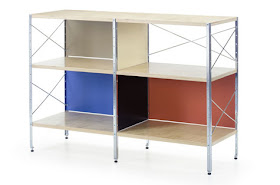Last week I posted about the first article in a three-part series on the Jet Set Modern website. The second contributor to the article "Is It Real?" is William F. Berg of Modern Wood Works in Kenner, Louisiana. His company manufactures a line of shelving based on the design of Eames shelving units. (First post: According to a Collector)
Berg clarifies the laws concerning inventions and designs, explaining two types patents:
- Utility patents - Protect inventors for 20 years. Charles Eames received a utility patent in 1942 for "A Method of Laminating Articles," which included the curved plywood chair.
- Design patents - Keeps a designer from being copied for 14 years. Eames received one of these in 1948 for the LCW (Lounge Chair Wood).
Once these patents expire, they can not be renewed. At that point, it is entirely legal for any manufacturer to use the design and put his own label on the resulting product.
Trademarks, which include words, names or logos that identify a product, can be renewed. For example, Knoll, Inc. has exclusive rights to the word Knoll when applied to furniture. Knoll also has the rights to the term Barcelona. Once the patent on a design expires and it enters the public domain, anyone can manufacture the item but cannot call it by its trademark name. Hence, all the inventive names given to Barcelona chair look-alikes, such as "The Pamplona," which is a regular in Craigslist ads.
Berg answers the accusation that manufacturing or buying a reproduction is unethical or immoral by pointing out that most Americans feel fine about buying generic drugs. Most have made copies on machines that were not made by Xerox, and most have talked on telephones not tied by pedigree to Alexander Graham Bell. Looking at it that way, maybe we are cherry-picking our causes about which to be righteously indignant.
Berg considers the terms knock-off, reproduction and re-issue (both "authorized" and "unauthorized") to be little more than sales ploys to discredit legitimate competitors who are operating completely within the scope of patent and trademark laws. He says that if a company is honest, makes a good product true to the original design that meets your needs and makes it at a fair price, buy it. He also reminds the reader that the original goal of the modern design movement was to make well-designed products affordable to the masses.
So...can you tell these apart without looking a my sources? One is a vintage Eames CSU, one is by Matt Blatt, and one is by Vitra.
 |
| The "authorized" version, 2011 vitra.com |
 |
| Replica by Matt Blatt mattblatt.com.au |
| The vintage Eames piece treadwaygallery.com |
Update: 4-19-2014 - The article that was originally on the Jet Set Modern site has been deleted, so I have removed the dead links from this post.

I think most of us mid century mod lovers / collectors strive to own original design pieces. For me, the key is price and functionality. We know there are treasures to be found for unbelievably low prices at thrift stores, etc. The availability of such treasures depends on what area you live in. I would be thrilled to own an Eames 670 lounge and ottoman, but, my budget doesn't allow $3,000 for a chair. That leaves me with the option of possibly being able to afford a knock off. It will never be the same as an original, but, if it's visually appealing, affordable and functional, I'm happy.
ReplyDelete@Krazy4Mod: If nothing else, this article has really made me examine my attitudes. I've always been offended by unlicensed copies of famous designs, but Berg's point about generic drugs put them in a different light.
ReplyDeleteGiven a choice, I will almost always opt for a generic drug or a store brand of a household product to save money, and I'm sure the companies who made the original put just as much creative energy, time and money into research and development as furniture designers did. Yet I've never passed moral judgment on a bottle of generic window cleaner like I have on a copy of a Barcelona chair, even though the legal and ethical principle is identical.
That said, like most mid-century lovers, given a choice between a real Barcelona chair and the "Pamplona" on Craigslist, I'll take the real one...if I can afford it.
I really expected this post to generate more spirited discussion than it has so far. Nobody out there want to string up Mr. Berg for daring to suggest (and me for seeing his point) that buying reproductions is like buying generic drugs?
ReplyDeleteI'm not attempting to address the question of right or wrong. I'm simply playing the devil's advocate and suggesting that, logically, it might make more sense to apply the same standard to one that we do to the other.
Surely someone out there wants to counter. :)